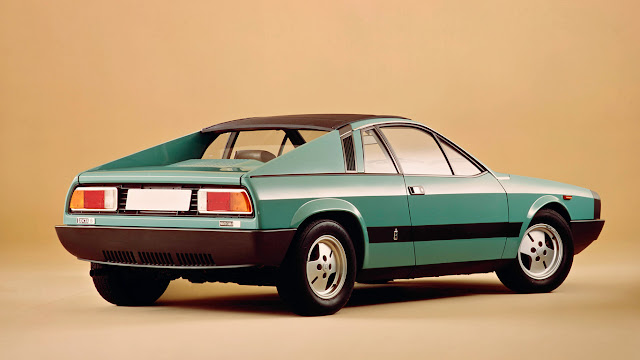
It’s summer, the season of hot days*, cool drinks and the thwack of willow on leather. It’s also the time of year when some rare and interesting cars emerge from their slumbers, ready to enjoy the taste of warm, unsalted asphalt.
Of course, some cars have a greater affinity for the road than others. And none more so than those whose engine sits behind the driver and ahead of the rear axle, such as the ones featured here.
But the cars I’ve chosen don’t just have a shared layout, they’ve all appeared in Hollywood films. Oh, and they’re all rare sights on UK roads, so you can count yourself lucky if you see even one of them this summer – just not quite as lucky as the person at the wheel…
Lancia Montecarlo
I seem to have an instinctive attraction to just about anything that resides in the ‘should have been a success’ file, and the beautiful Lancia Montecarlo is no exception to that.
Originally conceived as a big brother to Fiat’s X1/9, the project jumped ship to Lancia, the end result emerging in 1975 as the Lancia Beta Montecarlo. Two versions were available: a fixed head coupe and a spider, the latter of which featured a roof that folded back into the B-pillar.
Only one engine was offered in European cars: a 2.0-litre DOHC unit with 120bhp on tap. Though power was reasonable for the time, the Montecarlo was no lightweight and performance was adequate rather than sparking.
In the USA, the Montecarlo was sold as the Scorpion, but in order to comply with emissions regulations it came with an emasculated 1756cc engine that offered a mere 81bhp and delivered performance that was inversely proportional to the car’s appearance.
Contemporary road testers felt that the Montecarlo was something of a curate’s egg. It looked wonderful and handled very well, but the performance was slightly disappointing, there was little internal storage space and noise levels were high even at cruising speed. The main problem, however, lay with the brakes.
From day one, the Montecarlo suffered from problems with its braking system. The brake servo, which operated on the front wheels only, was too heavily assisted. As a result, it was easy to lock the front wheels under braking, especially in the wet. It took a while, but Lancia eventually acted, withdrawing the Montecarlo from sale so that the braking issues could be rectified.
It re-appeared nearly two years later, the braking issue having been addressed by removing the servo assistance and fitting larger discs and calipers. But that wasn’t the only change: amid several other cosmetic changes, the rear three quarter buttresses had been opened up to aid visibility. The car had a new name, too – henceforth it would now be known as the Lancia Montecarlo, a change that most people felt was for the, ahem, Beta…
The Montecarlo’s return was, alas, short-lived. The last examples rolled off the production line in 1981, after a grand total of 7,578 roadgoing models had been made. Today, they’re a rare sight, with only around 50 Montecarlos being taxed for use in the UK. And that’s a pity, because the Montecarlo exudes even more charm than Dean Martin on the pull…
Maybe that’s why Disney cast a Scorpion in the role of Herbie’s ‘girlfriend’ in the appropriately titled, Herbie Goes to Monte Carlo.
Matra M530
Want a distinctive mid-engine car with pedigree, but require more than two seats? If so, you’re not exactly spoiled for choice. A Ferrari Mondial is one possibility; the Lotus Evora another. They’re both a bit on the pricey side, however, and the Lotus doesn’t exactly offer much in the way of back seat accommodation.
But there is an option. If you can find a good one and you’re willing to accept major league quirkiness as a standard feature then a Matra M530 might just be what you’re looking for.
Since it’s reasonable to assume that you’ve probably never heard of the M530 let alone seen one, allow me to make the introductions.
The Matra M530 was the world’s first production mid-engined 2+2 coupe. Powered by a 1699cc Ford V4 engine, as used in various Fords and later versions of the Saab Sonnet, the little Matra wasn’t exactly a road burner. It could just about top 100mph, and its acceleration was the very epitome of Gallic insouciance, with 60 coming up in around 14 seconds.
In spite of its lethargy, the motoring press loved the M530. Its handling, roadholding, ride comfort, practicality and fuel economy all came in for particular praise.
Over the course of its production life, three models of the M530 were produced: the M530 A, M530 LX and M530 SX. Both the A and LX models came with pop-up headlights and a split, detachable targa roof. The SX, Matra’s attempt to offer a lower cost model to buyers, came with a fixed roof and fixed lights.
As for quirkiness, well just take a look at it. If you thought avant garde was French for front bumper then think again! The M530 is a motorised piece of modern art. You may like it, you may not – but you can’t ignore it.
Matra made 9,609 M530s from 1967 to 1973. Most have long since gone to the great arthouse in the sky, courtesy of a chassis that was largely bereft of protection against corrosion. It was never produced in right-hand drive form and few came to the UK. It’s not known how many (or, rather, few) remain the UK, so if you’re looking for one, continental Europe should be your hunting ground.
The M530 may not look like a typical matinee idol, but that didn’t stop it from sharing screen time with the King of Cool. Next time you watch Le Mans (the film, not the race – do pay attention at the back), keep an eye out for the scene where Steve McQueen walks past an M530 parked outside the Matra-Simca team’s motorhome.
Pontiac Fiero
Pop quiz: What mid-engined sports car made its debut in the first half of the 1980s and racked up over 350,000 sales within five years?
It has to be the Toyota MR2, right?
Wrong. It’s the Pontiac Fiero. Now, some of you may be shaking your heads and muttering something along the lines of “The Pontiac what? Never heard of it…” If you’re one of these people, I would cordially suggest that you return to your former school, college, university or Young Offender’s Institute and demand an explanation as to why they permitted you to leave with such a glaring gap in your knowledge. Tell them I sent you. They won’t have heard of me either…
Now that we’ve got that out of the way, let’s take a look at the Fiero. It was launched in 1983, had two seats and featured plastic body panels over a spaceframe chassis. Not your typical American car, then.
The Fiero was initially available only as a notchback coupe powered by General Motors’s 2.5-litre, 4-cylinder ‘Iron Duke’ engine. The engine options were doubled in 1985, when a 2.8-litre V6 unit was added to the range, and the following year saw the introduction of a fastback ‘GT’ model.
The Fiero could, and should, have been a great success for Pontiac, but it was the result of a cut-price development programme; a mass-produced sports car built using key components from more humdrum models without adequate thought as to their suitability.
The Iron Duke engine was a case in point: its output of 92bhp might be acceptable in a compact saloon, but was hardly in keeping with the Fiero’s racy image. The four cylinder Fiero wheezed its way to a maximum speed of 105mph and couldn’t break 11 seconds for the dash from nought to 60. Power delivery also left a lot to be desired, thanks to the long-stroke engine’s disdain for revs.
More significantly, perhaps, the Iron Duke’s oil capacity was stated to be a little under two pints lower than it actually was. Not good in a car that was likely to be driven enthusiastically, especially in light of the engine’s propensity for developing oil leaks. Worse still was the revelation by a GM foundry manager that up to 40% of the connecting rods installed in Iron Duke engines were substandard. Indeed, these defective conrods were to play a key role in the demise of the Fiero.
The use of saloon car components and the heavy metal spaceframe meant that the Fiero was heavy by the standards of the day, tipping the scales at a little under 1,200kg. This added weight didn’t just blunt its performance, handling suffered too. When Road and Track conducted its first test of a Fiero in 1983, the car was described as surprisingly cumbersome.
The Fiero was initially a huge sales success, exceeding even Pontiac’s somewhat optimistic sales targets. It wasn’t long, however, before reliability issues with the Iron Duke engined version of the Fiero came to the fore, including a spate of engine fires courtesy of an unholy trinity of oil leaks, oil starvation and those defective conrods. Pontiac’s handling of the problem came in for much criticism and the company was eventually forced to issue an all-model recall. Sales plummeted to half their original level and never recovered.
By the start of 1988, Pontiac’s parent company, General Motors, was in the middle of a massive rationalisation and cost-cutting programme. The unreliability of early Fieros had led to significant sums being spent by the company on warranty repairs, to which would soon be added the cost of implementing the recall programme. Enough was enough, said the suits at GM: Fiero production would cease in 1988.
It was a sad decision for both the car and the workforce that had built it, for by the end of its production life the Fiero was a rather better proposition than it had been at launch. The V6 engine endowed it with a good turn of pace, the GT model was attractive and, for 1988, the Fiero finally received the suspension and brakes it should have come with from the beginning.
With bitter irony, no sooner had a fine car emerged than it was sentenced to death.
It’s still relatively easy to pick up a Fiero today. If you live in the USA, that is. Just make sure that you buy a 1988 model, preferably a V6 GT with a T-top and manual ‘box…
Indeed, it was a 1988 Fiero, a notchback with Scooby Doo seat covers (nope, me neither) rather than a GT, that Michael Bay picked up for Mark Wahlberg to drive in his 2013 turkey, Pain & Gain. That’s two hours of my life I won’t get back – don’t say I’m not good to you….
*except for viewers in Scotland.














EmoticonEmoticon